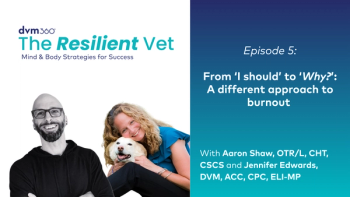
Fit to Practice: 7 steps to staying positive in a negative world
You can't stop life's waves-or the ones you may encounter in veterinary practice-so you might as well learn to surf.
I wish I was more like my dogs—they’re eternal optimists. No matter what’s occurring around them, they continue to wag their tails, stare affectionately, and forgive instantly. Their bowl is always half-full.
Now don’t misunderstand me. I’m a pretty positive person—perhaps even more hopeful and cheery than most. But I have moments that challenge to wreck my enthusiasm.
So how do I stay upright when my world turns upside down? How do I stay afloat when my boat capsizes? I pause, reflect, and remember. I also use these tactics to stay on course when my life threatens to veer out of control.
1. You’ve got to want it.
The first step to surfing life’s stormy waves is to commit to being more positive. You’ve got to have a strong commitment to becoming and living more positively. Sometimes at conferences I’m shocked when people say, “My life isn’t like yours. If I had it easy like you, I could be happier, too.” Nothing could be further from the truth. We all face tribulations, tests, and turmoil. It’s how we deal with them that distinguishes us and ultimately determines our success and happiness.
The first step to being more positive is to, well, be more positive. At first, maintaining a cheery attitude takes tremendous effort. But as you see the rewards, it gets easier. Before you know it, people are treating you better because you’re more fun and pleasant to be around. That positive feedback further fuels your desire to be upbeat. But you’ve got to want it first. This isn’t something that happens to you—it happens because of you.
2. Anything is possible.
One of my personal heroes, Napoleon Hill, said it this way, “Who said it could not be done? And what great victories has he to his credit which qualify him to judge others accurately?” Exactly. I’ve led my life by never entertaining the thought that I couldn’t do something. Write a college music hit without knowing how to play an instrument? Why not? Build an award-winning, internationally known, and highly successful veterinary clinic in a town of 1000? You bet. Complete an Ironman without ever running a marathon first? Sure. I missed the life memo that advised checking with someone else before dreaming. I choose to dream—big.
3. Be realistic.
Just because I believe—and truly believe—that anything is possible, doesn’t mean I’m not realistic. “Anything is possible” requires hard work. Before I wrote that hit single, I went through a number of instruments (settled on bass guitar), devoured every bit of musical information I could find, and practiced until my fingers bled (and bled some more). My musical experience also took me to a level that I realized was probably my limit. To try and break onto the greater national rock scene would’ve meant delaying or foregoing my veterinary career. (This all was happening during veterinary medical school. Yeah.) I was realistic. I took that dream as far I thought possible and then moved on. That’s another key tenet to staying positive.
4. Relentless forward progress.
Life is not a bell curve with the best living in the middle followed by a gradual disintegration to death—at least not to me. Instead, it’s a series of curves reaching ever upward until suddenly you drop off. That’s what I’ve been doing. As one part of my life reaches a peak, I catapult those skills and experiences into advancing another aspect of my life. Progress isn’t simply about doing the same thing better and better, it’s about doing other things better and better. There is a limit to what you can do in one area before you need to branch out into another, typically similar one.
As a young veterinarian, I first mastered the basics: exams, common medical conditions, managing human resources, and so on. As I excelled in managing staff, I then challenged myself in a new manner to lead people. As my exam skills improved, I reinvented how I communicated with clients using technology and non-verbal communications. And as a runner: 5K to 10K to half-marathon to Ironman triathlon and beyond. (Yes, I’ve got a “beyond” developing in the physical area as I write this. I’m excited, nervous, even scared because it seems impossible and everyone’s telling me “don’t,” “can’t,” and “shouldn’t.” All good signs that I’m exactly on track.) Relentless forward progress. Never stop challenging yourself. At the point you find success, reinvent whatever you’re doing. Success is the enemy of innovation.
5. It’s your responsibility. Your life is your responsibility. If you’re an adult reading this, it’s time to accept accountability for your current predicament. Bad, even awful, things may have happened to you in the past. But tomorrow is yours. What you do, how you approach it, and whether or not you find happiness is all within your control.
I find that too many veterinary healthcare providers blame their boss, co-workers, managers, even clients for their troubles. Stop it. Change it. If you can’t change the system—and you’ve got to really try—change systems. Switch jobs. Fire staff. Our life is ultimately up to us. YOLO (You only live once, guys). Make it beautiful. Life’s too short to persist in a bad environment or with people not interested in improving themselves.
6. Like begets like. I first learned of this truth in freshman biology. Similar or “like” animals, bacteria, protozoa, or whatever tend to like similar beings. Further, two similar genes produce similar traits. This was echoed in inorganic chemistry, physics, and later in medicine. Because I was busy being a musician in college, I probably misunderstood all of the science and distilled it into a life philosophy. I took it to mean that if I hung out with people I wanted to be more like, I would become more like them. I discovered that cool musicians, artists, philosophers, scientists, and successful people tended to run in social circles with equally, or more so, successful and talented people.
When I started my practice, I sought out the most successful people I could find—and that would have me—in my area. The most obvious reflection of this belief in my life is that I’m married to a woman who is much better looking and more articulate, intelligent, empathetic, and incredible than I could ever hope to be. I married up—way, way up. And it’s stuck since I first risked failure by asking her out in 1986. I attribute it to the belief that I wanted, and still want, to be more like my amazing wife.
Are the people you spend time with making you better? If not, why not? Do you want to occupy your life with people that make you feel worse, unhealthier, unhappier, and aren’t exposing you to new challenges, thoughts, and helping you improve yourself? This is a simple choice for adults. Start by introducing yourself to people you want to be more like. Make friends with people who can help you change your life. I’m so thankful my wife hasn’t figured out what a goof I really am.
7. Be thankful. Gratitude is one of the principal reasons I’m so darn happy all the time. I can’t believe how great my life is. I live in a free country, I get to pursue my childhood dream, I have great friends and colleagues, I have two amazing children, and my wife loves me deeply—despite all my shortcomings. Plus she’s an unbelievable cook. I’m so thankful for all I have. And I’m conscious of this constantly. Gratitude is on a constant loop in my mind. I’m thankful my car just started. I’m thankful I have a car. I’m thankful for the parking space. I'm thankful for fresh, nourishing foods at my grocer. I'm thankful I have resources and opportunities to sustain my mind, body, and spirit. On and on it goes, never ceasing. I’m not joking. This constant state of thankfulness isn’t a neurosis—it’s a healthy reminder. I'm lucky. I'm privileged. I'm grateful.
You can choose to be grateful for what you have, no matter how small or insignificant it may seem, or you can choose to complain about what you don’t have. The happiest people I know focus on what they have, the skills they possess, and the opportunities for future growth instead of all the garbage that can sink even the most buoyant spirit. They ignore what they don’t have and focus on ways to get it, if whatever they’re lacking is deemed worthwhile and beneficial. Be thankful you have the choice.
A lesson from real surfing
I just told you about seven basic steps for learning to ride life’s neck-snapping waves. Now what about riding real waves? How does that relate to the trials we face in life?
One thing I love about surfing is the opportunity to harness the most powerful energy in nature. When you get it right, you share an intimacy with nature that’s unrivaled. The stoke, flow state, and euphoria you feel after stepping off a powerful wave are largely indescribable.
I’ve also learned some of my most valuable lessons from my wipeouts. As a large set wave looms on the horizon, I'm filled with elation and anxiety, thrill and fear. The biggest wave of the set is coming and I don’t know fully what to expect, only I’d better get ready. I paddle madly, feel the surge beneath my board and pop up, every muscle and neuron firing to keep me upright, in control, and in sync with this massive force.
Suddenly I slip, the wave bucks, or the wind shifts and complete chaos ensues. I fall—out of control and suddenly realizing this is no pleasure cruise. Thousands of pounds of brute force meet brittle bones and thin skin. My exposed face smacks the trough of the wave so hard I see stars. The invisible hand of the wave pushes me down into the darkness below. I plummet so deeply what little air I managed to suck in is squeezed out of my lungs. I reflexively suck back stinging salt water. And then I have a choice—fight or flight, tense or relax, maybe live or die.
In that moment I realize it’s not the wave that poses the problem—it’s me. So I relax, take my bearings, and stroke for the surface. Once I break free of the wave’s grip, here comes another, threatening to drown me all over again; another choice and another, until at last the set has passed.
I know from experience that eventually a lull will creep in if I just stay focused, keep my cool, and use my abilities. I’ve been in some pretty sketchy situations over the years, some I wish I could forget. But I love the challenge, love the feeling, and ultimately love the lessons I learn about myself. I’m grateful for every wave. Surf’s up. See you on the water.
Newsletter
From exam room tips to practice management insights, get trusted veterinary news delivered straight to your inbox—subscribe to dvm360.




